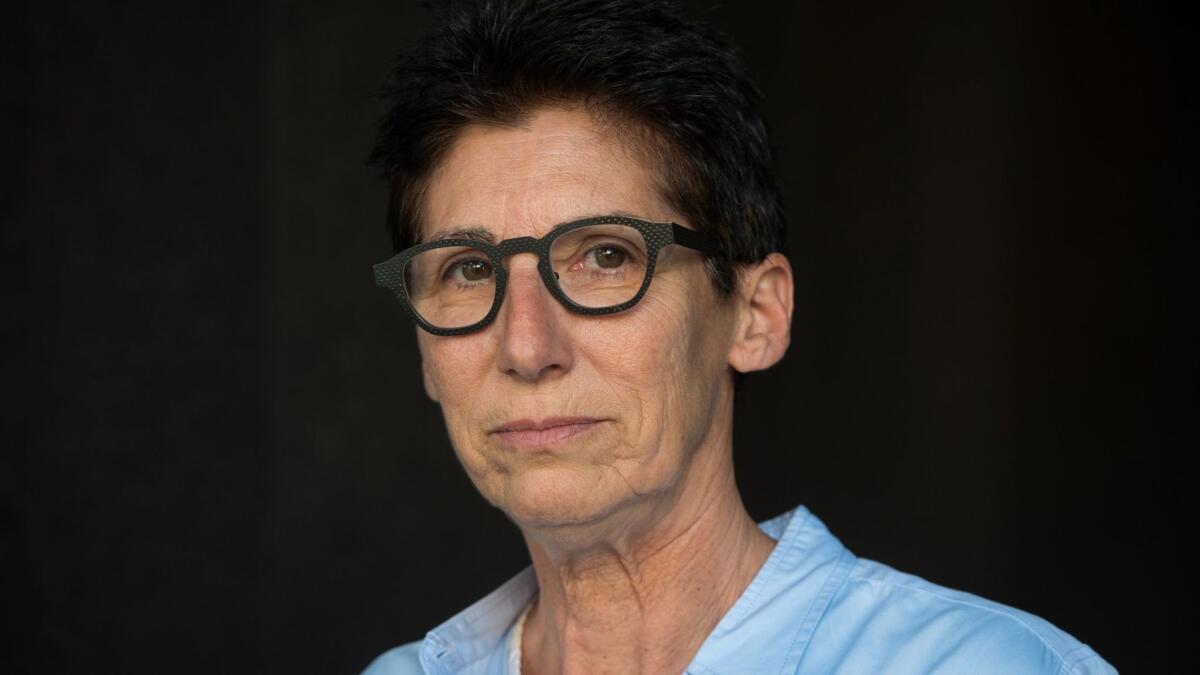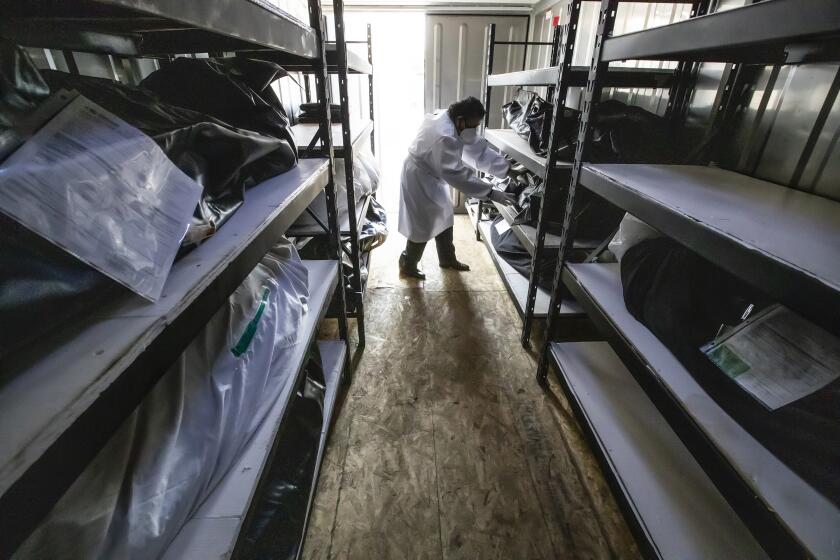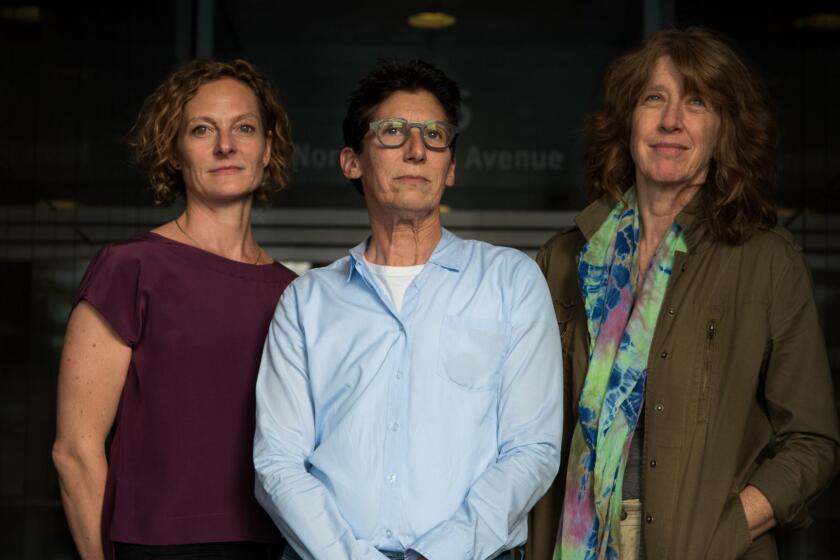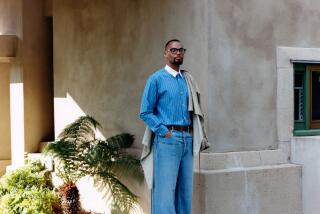‘Mayday!’: Artist Susan Silton asks us to send Donald Trump names of our COVID-19 dead

In a week in which we mark 200,000 lives lost in the U.S. to the COVID-19 pandemic, a work by a Los Angeles artist channels the loss and the anger generated by the high toll.
“MAYDAY! MAYDAY! MAYDAY!,” a participatory artwork created by Susan Silton, is simple in its premise. The artist is asking individuals to write the name of someone who has died from COVID-19 on a piece of paper and slip it into an envelope emblazoned with bold logos that read “Mayday!” (available as a free download on the the project’s website). The missive is then mailed to Donald Trump at the White House and the name of the deceased registered on Silton’s website.
Silton created the work in early May, before the toll had reached 200,000, before the uprisings in the wake of George Floyd’s killing in Minneapolis, and before the slow dismantling of the U.S. Postal Service had become part of the daily drumbeat of news. But she finds that the project’s impetus — to name those we have lost — has remained relevant throughout.
“I created that piece out of rage,” she says by telephone. “And that rage has continued.
“It has migrated from one issue to the other. All of these issues are not one and the same, but at this moment, everything feels completely related. You can’t talk about the pandemic without talking about structural racism. You can’t talk about structural racism without talking about the corruption of this president. You can’t talk about the pandemic and the response to it without talking about history.”
The U.S. death toll — 200,000 — from the coronavirus has passed the total from WWI and the Vietnam War combined. Here’s a look at COVID-19’s place in history.
History is something that Silton regularly engages in her work. In 2017, she staged a performance inspired by a quartet written by French composer Olivier Messiaen as he was on his way to a Nazi prison camp.
In another piece that touches on the World War II-era, she tracked the ways in which the rise of the Nazis in Germany was chronicled by the U.S. news media. For that project, titled “A potentiality long after its actuality has become a thing of the past,” she reproduced five front pages from the New York Times of the 1930s and mailed them to colleagues and political journalists. The project has a gallery component too, which features photography and the original newspapers. (It also inspired a short film by director Dana Berman Duff.)
To read through the clips is to see a relentless focus on the daily headline at the expense of the bigger picture — and it couldn’t be more relevant at this moment, when conservative strategists are already calling into question the presidential election if Trump fails to win. (As former George W. Bush advisor Stuart Stevens said to Vanity Fair recently: “People say we can’t talk about Hitler, we can’t talk about World War II Germany. I think we have to.”)
In this conversation, which has been condensed for clarity, Silton talks about why she was moved to make a work of mail art at this moment in history and what it is we can learn from her stack of yellowed copies of the New York Times:
What was the genesis for “Mayday!”?
I thought, I have got to do something, I am filling up, boiling over in quarantine with angst and upset about what is going on. Louis DeJoy had been selected postmaster general. I knew where he came from, that he was a Trump loyalist, that he had never worked in the Postal Service. I just love philately. In my life I’ve been a stamp collector and I’ve tended to use the Postal Service for art projects. On April 12, I posted a petition that demanded Congress fund the U.S. Postal Service in the stimulus bill.
I saw the expression “Mayday! Mayday!” and I learned about its origins as a distress signal. I wanted this work to be both a place to honor those who have passed and a space of quiet protest — and, most important, a space to support the Postal Service. I did not have any illusion that these letters would reach the White House. They certainly wouldn’t be seen by the president. But to write somebody’s name means you are thinking about that name, so for me it became an active forum of memorializing.
What comments have you received through the project that have been poignant to you?
Not one in particular. I would say collectively, when I have looked at them, it has brought tears to my eyes. Some of them are extremely heartfelt. It’s the collective weight of people mourning. The idea is to create a wall of a very different nature that comes from rage, but has equal parts tenderness — which is something we are drastically missing in our lives right now.
I want to go back to “A potentiality,” when you mailed out reproductions of newspaper front pages tracking Hitler’s rise.
The piece comes from an iconic work by Hannah Arendt: “Eichmann in Jerusalem: A Report on the Banality of Evil.” It’s a very apt text. The banality of evil, in the way that she wrote about it, it’s not what you think. The way it’s framed by her is that it’s almost a question of labor and economics. People that do evil are often times just following orders and that’s what the banality is. It’s not that evil comes in the form of banal-appearing incidents. It’s that those who ultimately do the dirty work of those who are authoritarians or fascists are doing it out of a banal sense of responsibility and duty — and it’s what we are looking at now.
This president has been systematically changing the guard so that any presence of someone who feels a responsibility to the Constitution, to the democratic principals of the country, are being forced out and are replace with loyalists who will answer to him. So when I found those newspapers in 2018, I sat with them for a while.
How did you find issues of the New York Times from the ’30s?
I came across them by chance. I was researching something and it led to a newspaper that happened to have a Hitler headline on it. I followed that trail to other newspapers that had the same and I purchased them. I purchased the actual newspapers. I couldn’t do anything with them for a while because I was trying to absorb what I found. I was haunted by them. I could not believe that in the early 1930s, we were reading articles in the New York Times about Nazi atrocities — it was so early and it was already being reported as news.
And that’s what was banal for me: the quotidian banality that becomes news. You’re looking at a front page and there’s something about a farm bill and something about banks and something about crime and something about German fugitives telling of atrocities at the hands of the Nazis.
A trailer for “A POTENTIALITY” by filmmaker Dana Berman Duff, inspired by Susan Silton’s work of the same name.
There is indeed a banality to some of the coverage: People allege atrocities; the Nazis formally deny. What was it like to track this history through the daily dribble of news?
Because the events around the Holocaust have been so historicized, we’ve forgotten what the quotidian was. Well, that quotidian felt incredibly resonant with our quotidian. It’d be interesting to go back to 2019: every week, every day, another piece of information, another part of the puzzle of democratic breakdown.
There was a paragraph [from one article] that I recently posted on Instagram. It talks about law and order. It reminds us of the boiling frog story — where we are right now, today. Three years ago, if there had been discussion about the Insurrection Act, and invoking that if [Trump] loses an election, we would have been in the streets. But there have been so many things to dodge in the three past years, it’s been designed to make us stay in the pot.
Whom did you mail these to? And what kinds of responses did you get?
I chose five to print; I like five as a number. Half of my lists were journalists and half were artists and arts institutions. And I would mail one [front page] at a time, in part because I wanted it to be a cumulative march. I got some meaningful responses from journalists. Patrick Kingsley, a New York Times reporter based in Berlin, posted the piece on Twitter as it was being sent and had an impact on him.
Another meaningful response was from this French journalist who wrote a book about the way in which the media covered the Holocaust. He wrote me back and said, “Wow, just wow. I have not been as chilled as when I first started to research this project — to see these newspapers in the flesh.” It was something like that.
You have a new project titled “We,” these pairings of images that reveal the ways in which different people might view the same thing.
I did a piece in 2010 as part of a project the art history department organized at USC. I had found these two Hollywood backdrops that were both titled “Desert Scene” and they were clearly painted by two different people at two different times. They looked very similar with a few exceptions. To the pairing, I added “We See It Differently, You and I.” It has stuck with me ever since.
Flash forward to just before the elections. I was thinking about that phrase vis a vis evolving politics and the way in which social media has informed that. I’d been spending time going up north, going to Guerneville and loving the Armstrong [Redwoods State Natural Reserve]. I started to shoot it and I was finding that that phrase came up a lot while I was in the woods.
When I think of “we,” I think of observation and the subjective body, not just in terms of me and you, but in terms of me and myself, the way in which I observe things differently from moment to moment. Some days I might think “X” and the next several days I might think “Y.” That’s how observation works. Observation is really fluid and it mutates.
In the woods, I took a whole series of images on my iPhone and the light would change in a given second and completely reveal the same scene in front of me as being different and I found that really important and relevant. I purposely shot these images with different filters — the same exact shot with a different filter. Then I wanted to step back and make photo etchings out of them — they are photo intaglios. It’s a complex process. I wanted it to be complex. Because they are etchings, there are no two that are exactly the same.
In each of these, in the phrase — “We See It Differently, You and I” — the verb “to see” is conjugated through 16 different pairs.
Have you been keeping track of the Armstrong reserve during the fires?
Thank God it’s been OK. I had been on the verge of hitting the Armstrong woods recently. I’ve been a mess with it — all of the animals, the ancient trees. It’s made me super sad.
On a bitterly cold night in January 1941, French composer Olivier Messiaen debuted a new work.
What has been your recipe for finding solace during this time?
The recipe has been a combination of yoga, watching birds in my backyard drinking from the fountain, and chocolate. At the beginning I was doing these chocolate chip cookies, then I had to deal with the COVID 15 — how much you gain. So I had to cut those out and I now do Lindt dark chocolate squares with sea salt.
More to Read
The biggest entertainment stories
Get our big stories about Hollywood, film, television, music, arts, culture and more right in your inbox as soon as they publish.
You may occasionally receive promotional content from the Los Angeles Times.













